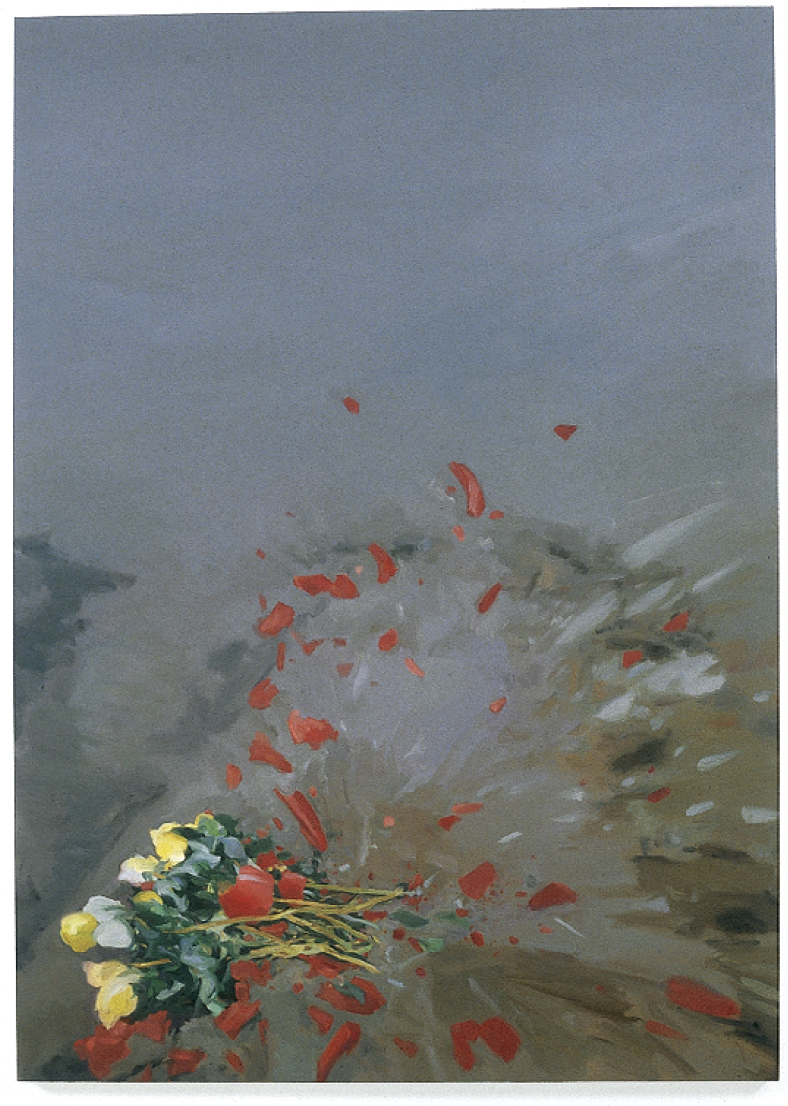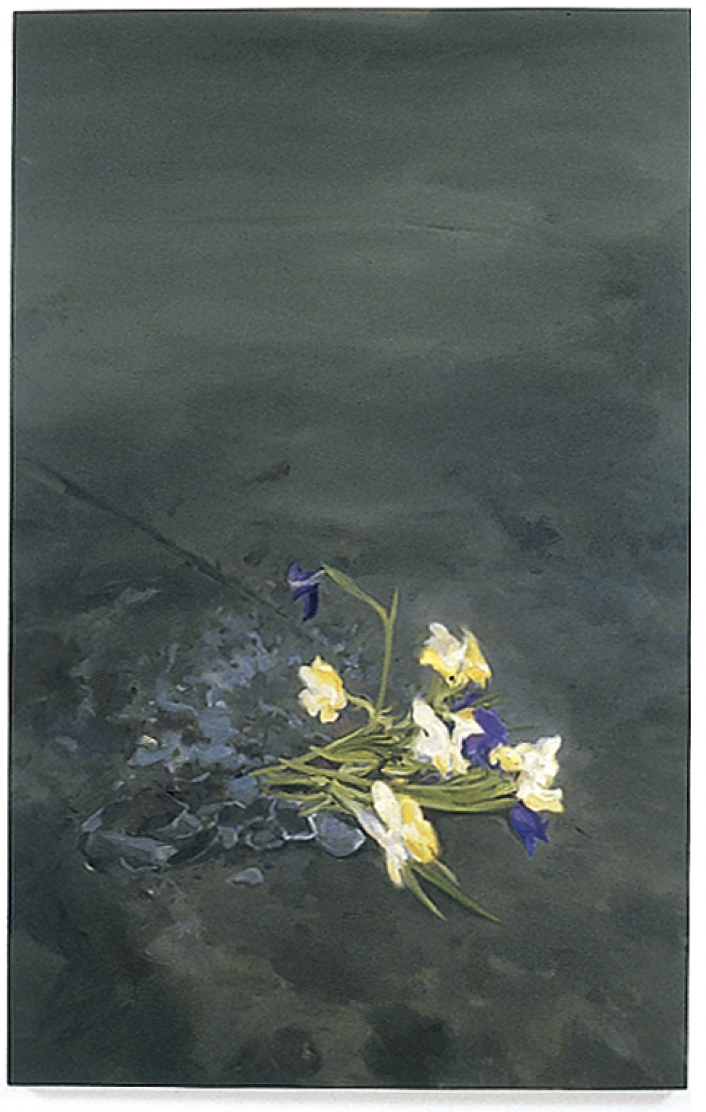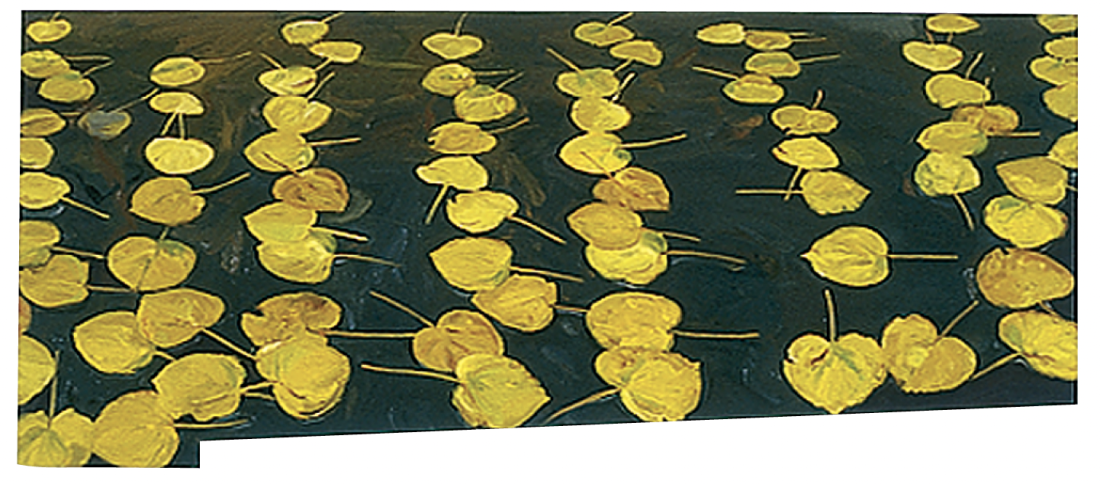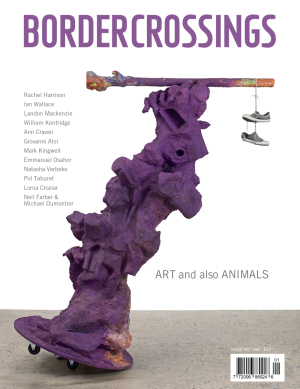Will Gorlitz
If, as Kant insists, beauty is the symbol of all things morally good, then Will Gorlitz’s new paintings are angelic, saintly, even transcendental in their moral goodness. Recently shown at the newly located Birch Libralato Gallery in Toronto, the exhibit was comprised of two untitled series hung to face one another in the gallery’s front space, as if in conversation.

Will Gorlitz, White and yellow roses/red vase, 2005, oil on canvas, 77 x 55”. Photographs courtesy Birch Libralato Gallery, Toronto.
On one side of the gallery were Gorlitz’s aspen leaf paintings, a subject he started studying nearly ten years ago and is now revisiting. Using the turning colours of the populus tremuloides, he shows the delicate yellow leaves on water, deep in layers of blues, greys and greens. The quality of Gorlitz’s representation alone would suffice, his way with colour and form enhancing nature beyond real life. Gorlitz, though, has chosen irregular surfaces—misshapen panels of wood—to paint on, as if he couldn’t quite contain the beauty on his brush, that it had to land on anything he could find. The paintings are wondrous, each quivering aspen leaf a little raft of floating perfection. These paintings speak to Gorlitz’s commitment to the possibilities of paint. Much of his earlier work played with visual and linguistic systems of representation— often using text and imagery appropriated from the media, photography, photocopies—to expand the visual strategies of painting. For some time—at least since he came to prominence within the early 1980s revival of figurative painting in Canada—Gorlitz has been obsessed with what he calls the “fundamental willfulness of painting,” something he sees as inexplicable, unpredictable and, lucky for us, inexhaustible. His urgent aspen paintings play with this wilfulness: his figurative strokes fill the picture plane in a hybridized nod to traditional landscape painting and to the Abstract Expressionist tradition of the self-conscious canvas.

Will Gorlitz, Blue and white irises/glass vase, 2005, oil on canvas, 73 x 46”
The other side of the gallery was filled with a series of paintings of shattered vases with flowers; giant and breathtaking, they are all done with Gorlitz’s standard mastery over paint and imagination. These works pay as much attention to the translation of details— the green stems, the daffodil and rose petals, the shattered pieces of porcelain and glass—as they do to the absence of detail. Most of the canvases are fields of muted colour with the implied space conveyed in graphite grey, soft blue and other subtle tones. Within the expanses of colour are layer upon layer of colours, blending to create a veil or mist over the entire, devastating scene; Gorlitz says almost as much or more with these backgrounds as he does with his foreground shatterings.
Flowers are one of Gorlitz’s favourite subjects, with their ability to equally convey love and death. Here, the significance of the flowers is thrown into question by the immediacy and violence of the act that he is depicting. Like sputtering goldfish on the wrong side of the tank, the flowers are strewn from their vases, gasping, terminal, witness to some act that we will never know. The smashed remnants all hover—as if just landed—along the bottoms of the canvases, the mists of colour creating a film or layer of tears between the detritus and us. Gorlitz has managed to paint movement with such authority that his paint still echoes from the fall.
Count on Gorlitz to put his hand through repeated testing. His dedication to painting the elements over the years—fire (as with Real Time, 1994), water (the Aspen works), earth (with Axis Mundi, 1995, his moon paintings, the various flower works, and his “Beyond the Pleasure Principle” series of decaying fruit), for example—is astounding; he captures some of nature’s most challenging moments with his wilful paint.

Will Gorlitz, Aspen Leaves, 2005, oil on shaped board, 25 x 79”.
Those moments are summarized by an underlying commitment to beauty, an idea that today still struggles under the shadow of conceptualism, where, to be taken seriously, beauty must be either politicized or serve some sort of therapeutic end. As Arthur C. Danto discusses in The Abuse of Beauty, 2001, even within postmodernist pluralism there is the sense that in some way beauty trivializes that which possesses it.
But Gorlitz ploughs through all that: the beauty of his paintings unfolds on so many levels, all of them superceding any insecurity about the function of the beautiful in contemporary art. Whether in leaf-form floating on the surface of the water or appearing in heightened, heart-wrenching narratives, Gorlitz’s figuration uses the beauty of colour (the blue of Gorlitz’s water just might be unequalled), form, subject matter and a balance of painted and implied space to overwhelm us with what, ultimately, is essential to art. ■
“Will Gorlitz New Paintings” was at Birch Libralato Gallery in Toronto from October 20 to November 19, 2005.
Julia Dault is a visual arts writer and critic; she writes a weekly column for the National Post called “At the Galleries.”

